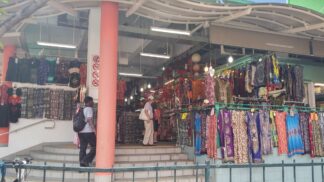There are many Chinatowns in the USA and other countries and, of course, they are quite different from each other, however, Singapore’s Chinatown is one of the oldest in the world.
In the early 1800’s, with only a small Maylay and nomadic population, Chinese started to settle on the east coast of Singapore and this area would evolve into Chinatown. With extensive land reclamation around the waterways beginning in the mid-late 60’s, soon after Singapore’s independence from Great Britain, Chinatown is now significantly inland. Currently, Singapore’s population is nearly 75% Chinese with the other major cultures being Malaysian 13.3%, Indian 9.2%, and other 3.3% (Phillipino, Indonesian and Westerners). While Chinatown has a higher concentration of Chinese there are also Indian and Maylay residents.
After living in Singapore for eight months, we’re getting a better understanding of the neighborhoods beyond the few things they are known for. Singapore’s Chinatown has its ubiquitous narrow, crowded and fun pedestrian shopping streets, two types of hawker’s markets/food vendor streets, and an upscale restaurant area, besides the shopping area more like State Street. It is one of the prominent gathering places for observing cultural celebrations each year.
Last weekend (early February) Gene and I went to see the decorations for Chinese New Year (first day of the lunar calendar is February 19 and it’s celebrated for 15 days) which is a very important holiday in Asia and preparations start very early. Each New Year is represented by the sign of the zodiac. This is the year of the goat; the appearance of hundreds of giant illuminated goats down the center of the main street in Chinatown and its image all over is the tip off. Every extra space in the markets are inhabited by vendors selling New Years decorations and items to bring good luck and prosperity for the upcoming year (see photos below).
It feels like a combination of Christmas and New Years Eve. Asians from different cultures tend to go back home to their parents’ home and feast. “Symbolically, new clothes are usually worn to signify the new year. It is also the tradition for every family to thoroughly clean their homes to “sweep away” any ill-fortune, making way for the arrival of good luck. Chinese New Year also brings people together, and is marked by visits to kin, relatives and friends, a practice known simply as “new-year visits”. The highlight for children and younger members of the family during these visits comes in little red packets, or “hong bao”, filled with money.
“Chinatown’s stunning streets are lit-up, night markets and decorations are the focal point for Chinese New Year celebrations in Singapore. This is when lion dancers, fire eaters and female dance troupes grace Kreta Ayer Square with their mesmerising performances. Armed with giant paper fans and intricately patterned umbrellas, they will provide you with street entertainment that you are unlikely to forget.
Folklore is very much at the heart of this festival. All across the city, you’ll notice dragon and lion dances everywhere – lending a cheery, festive atmosphere to the occasion. Dragons and lions are prominent characters in Chinese mythology; its roots originating in ancient China when Nien, a mythical beast which tormented villagers was discovered to be afraid of the colour red.”

Gene, her mom and I in Chinatown pedestrian shopping area.

Chinese New Year decorations shop

Chinese New Year Street with goat decorations

Chinese New Year street decorations at night

Chinese New Year main street in February

Chinatown dress store

Lanterns above Pagoda Street

Looking down on Pagoda Street and MRT entrance

Tea shop of aged pressed tea

Sharkfin shop, an Asian delicacy (although going out of favor)

Traditional shop fronts

Custom tailor shop

Shops with tall, narrow apartment building in center

One of the pedestrian shopping streets

Friend, Mandy from Hong Kong, Gene’s mom and Gene.

Hawkers Food Markets on both sides and down the middle

Chinese Temple

Chinatown roof tops against downtown skyscrapers

Paper lanterns painted by children

Decorations above street for Mid-Autumn Festival in September

Moon cakes central to the Mid Autumn Festival

Sculpture in Chinese Temple
























































